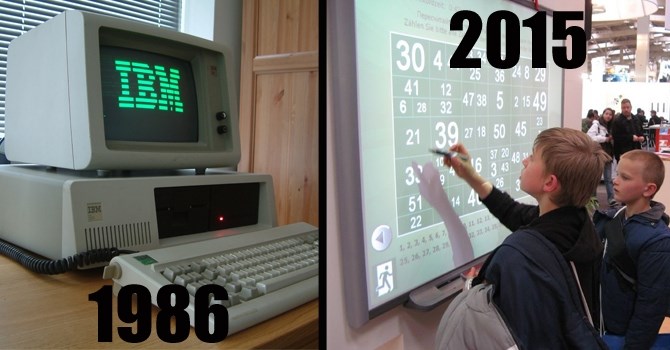
Times have changed the technology used in classrooms.
Image Credit: Compilation/Wikipedia
June 12, 2015 - 9:27 AM
KAMLOOPS - If you've been in a school lately you might notice things look a little different than when you were a student. You will find SMART Boards in many classrooms as well as computer labs and mobile iPad labs in most schools.
School trustee Gerald Watson came to Kamloops in 1977, when he started Grade 1 at Sahali Elementary, and in 1989 he graduated from Kam High. Since then he has watched technology in city schools change dramatically.
Within the last decade all schools have seen a major upswing in technology, according to Watson.
“It would be unfair to say (the use of technology) would be completely correlated to age, but generally speaking the younger teachers are adapting to it more than the people who’ve been around a bit longer,” Watson says.
Many schools in the district now have iPads, in part thanks to a grant program set up through Apple. Students are able to sign out the devices like library books to complete class assignments that range from research to creating presentations and iBooks.
Classes are also using Chromebooks, a lap top that runs on an Android interface, and classroom SMART Boards. A SMART Board is an interactive white board with many of the same capabilities as a computer that has essentially replaced the overhead projector.
While Watson figures it would cost roughly $3 million to put a SMART Board in every classroom that School District 73 operates, over the course of six or seven years they’ve gotten quite close. Over the next three years the district has budgeted more than $600,000 for the district technology plan.
“Pretty much everyone who wants (a SMART Board) has got one in their classroom at this stage,” he says.
Watson calls the level of technology during his school years 'comparably zero' with what is present today. In 1986, when Watson was just finishing Grade 7, Sahali Elementary purchased one computer for the library.
“It was little more than a word document that had a list of all the books in the library,” he says, noting the computer wasn’t capable of checking books in or out, it could only tell you they existed within the library. “Because I had (a computer) at home I knew how to use it. The librarian had me play with it to give her ideas of how to use it.”
Watson says adults, at the time, had no concept of computers and only kids that had enough patience would figure those things out.
PROVIDING MORE OPPORTUNITIES
According to Watson, technology at the secondary school level has changed the most. Not only in terms of new, cool applications, but in changing the way that students learn.
“There are special programs in Sahali, for example, on DigiPen — a programming language for graphic video games. It’s a precursor to becoming a graphic programmer.”
But perhaps more impressive, are the new opportunities for students in remote locations.
“In the upper-level courses (fibre-optic cable) turned distance learning on its head,” Watson says.
In the past smaller schools like Logan Lake would not be able to offer a Grade 12 physics class because of a lack of students. But through teleconference, those schools can virtually sit in on a class from Kam High now.
“It gives them a course they wouldn’t usually have,” he says.
This teleconferencing ability also means classes at all levels can meet students across the world or can take 'virtual field trips' to larger museums like the Cleveland Museum of Natural History.
Changed also, from his time until now, are the attitudes of parents. Watson says there was a perception in the eighties if a child had a computer they would be miles ahead of other students. Today, this feeling is nearly the opposite.
“Most of the parents are on the same page; by and large (technology is) a distraction and they have to be persuaded there is any educational value.”
To contact a reporter for this story, email Dana Reynolds at dreynolds@infonews.ca or call 250-819-6089. To contact an editor, email mjones@infonews.ca or call 250-718-2724.
News from © iNFOnews, 2015